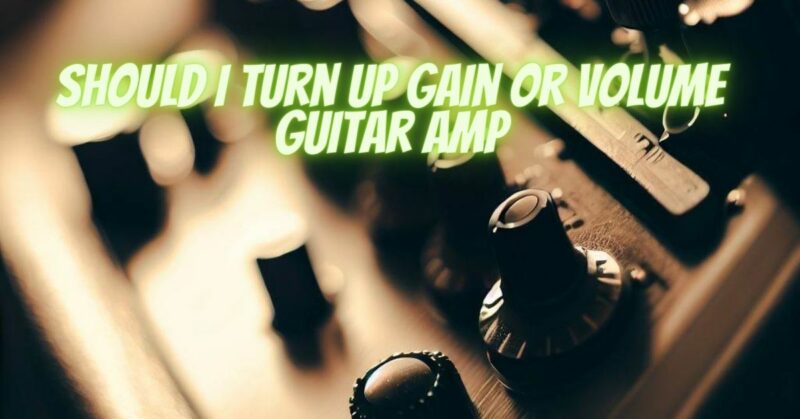When it comes to dialing in the right guitar tone on your amplifier, the settings can sometimes be a bit confusing. Two essential controls you’ll encounter are “gain” and “volume,” both of which play a significant role in shaping your guitar sound. In this article, we’ll explore the differences between gain and volume on your guitar amp and discuss when and how to adjust them to achieve the best results for your playing style.
Understanding Gain and Volume
- Gain: Gain, often referred to as “overdrive” or “distortion,” controls the amount of signal amplification and saturation applied to your guitar’s input signal. It adds grit and crunch to your tone, and at higher settings, it produces the characteristic distortion associated with rock and metal genres.
- Volume: Volume, as the name suggests, controls the overall loudness of your amplifier’s output. It determines how loud your guitar sound is relative to the amplifier’s capacity, and it does not affect the level of distortion or overdrive.
When to Adjust Gain
Adjusting the gain on your guitar amp is essential for achieving various tones and styles. Here are some situations where you should consider adjusting the gain:
- Clean vs. Dirty Tones: Lower gain settings result in cleaner, more transparent tones suitable for jazz, country, or softer rock. To get a distorted or overdriven sound for classic rock, blues, or metal, increase the gain.
- Soloing and Lead Lines: If you’re playing solos or lead guitar lines and want them to stand out with sustain and saturation, increasing the gain can help you achieve a singing, expressive tone.
- Genre and Style: Adjust the gain based on the genre or style you’re playing. For example, metal and hard rock often require high gain settings, while funk and pop may call for cleaner tones.
- Artistic Expression: Experiment with gain settings to shape your unique guitar voice. Different gain levels can evoke specific emotions and add character to your playing.
When to Adjust Volume
Volume, on the other hand, controls the overall loudness of your amplifier. Here’s when you should consider adjusting the volume:
- Sound Balance: Use the volume control to ensure that your guitar’s output level is balanced with the rest of the band, whether you’re practicing, recording, or performing live.
- Stage Presence: When performing with a band, adjust your volume to cut through the mix and be heard clearly by both your bandmates and the audience.
- Noise Control: Lowering the volume can help reduce unwanted noise or feedback, especially when using high-gain settings.
- Dynamic Control: Adjust the volume to control the dynamics of your performance. Lower volume can create a cleaner, chimey sound, while higher volume can produce a more aggressive, punchy tone.
The Balance Between Gain and Volume
The balance between gain and volume is key to achieving your desired guitar tone. Here are some tips for finding the right equilibrium:
- Start with Gain: Begin by setting your gain to achieve the desired amount of distortion or overdrive. Dial in the gain until you’re satisfied with the character of your tone.
- Fine-Tune with Volume: Once you’ve set the gain, use the volume control to adjust the loudness. Ensure that your guitar sound is at an appropriate level for the context, whether you’re practicing, recording, or performing.
- Listen Carefully: Pay close attention to your tone as you adjust gain and volume. Listen for clarity, sustain, and how your guitar sits in the mix. Make small adjustments as needed to find the perfect balance.
- Experiment: Don’t be afraid to experiment with different gain and volume settings. Explore the full range of possibilities to discover new tones and textures.
In the world of guitar amplifiers, both gain and volume are essential controls that allow you to shape your guitar tone and control your output level. Gain adds distortion and character to your sound, while volume determines how loud you are. By understanding when and how to adjust these controls, you can unlock a wide range of sonic possibilities and tailor your guitar tone to your unique style and musical vision. Whether you’re chasing a clean, crystal-clear tone or a searing, overdriven sound, finding the perfect balance between gain and volume is the key to achieving your desired guitar tone.


